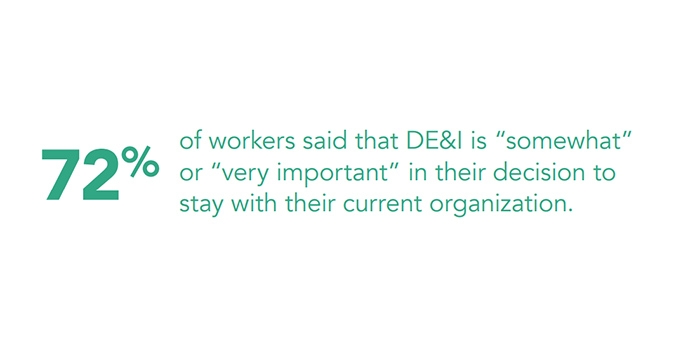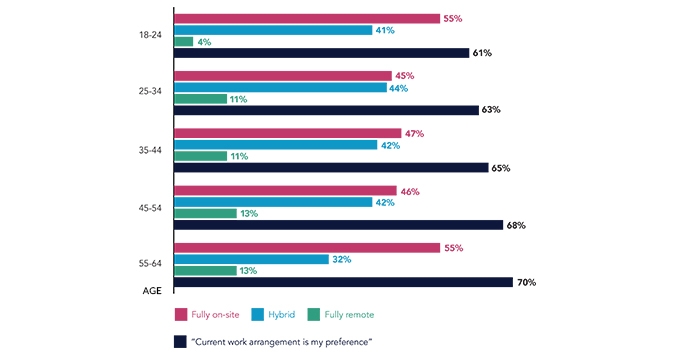Understanding Generational Differences in the Workplace and How to Manage Them

Having employees from a variety of generations can have great benefits for your company, from expanding perspectives to creating a team with an arsenal of complementary strengths. However, managing generational differences in the workplace can be uniquely challenging, as your employees may all have vastly different needs and goals.
This article will help you understand how to create better organizational effectiveness and inclusivity in a multigenerational workplace.
What are generational differences?
Generational differencesOpens in a new tab are variances in lifestyles, preferences, habits, and values that were shaped by the time period in which an individual was raised. These may include an individual's political views, feelings toward money, relationship to authority, career goals, or a variety of other aspects.
These ideologies can be shaped by shifting international relations, technological advances, socio-political movements, collective tragedies, dominant religious ideologies... the list goes on.
These ideological differences can cause employees to behave very differently in the workplace. By gaining a deeper understanding of why employees of every age view things the way they do, you'll be able to more effectively meet their needs and manage your team more productively.
What are the five different generations currently in the workplace?
Here is a quick breakdown to help you understand what employees from each generation value in the workplace:
Traditionalists, or The Silent Generation
- Born 1925-1945
- Currently, make up 2% of the American workforce
- These employees tend to be less concerned with workplace culture, and their view of labor is more financially transactional
- Traditionalists tend to stay in roles and at companies longer than members of any other generation, valuing stability, security, and loyalty above all else
Baby Boomers
- Born 1946-1964
- Currently, make up 25% of the American workforce
- Appreciate clear goals, deadlines, and long-term planning, both for their individual careers and for the company as a whole
- Highly ambitious and career-driven, these employees are driven by promotions, rewards, and other accolades to confirm that they're "climbing the ladder" successfully
Generation X
- Born 1965-1980
- Currently, make up 33% of the American workforce
- Want to work somewhere where their professional experience is valued and where they are fairly compensated for all of their contributions
- Seek out clear, consistent feedback and prefer to have important conversations face-to-face
Millennials
- Born 1981-2000
- Currently, make up 35% of the American workforce
- Look for community in the workplace, seeking companies with strong cultures and opportunities for personal and professional development
- Value autonomy and a high degree of flexibility, often opting to work remotely or hybrid
Generation Z
- Born 2001-2020
- Currently, make up 5% of the American workforce
- Value diverse, inclusive workplaces and mission-driven companies
- Prioritize individualism and prefer to work independently, valuing their personal career journey above corporate success
How do you manage each generation?
Because they value such different things in the workplace and in their personal lives, it should come as no surprise that these generations not only need to be managed differently but also require distinct approaches to managing up in order to maximize their work experiences.
Traditionalists
The main concern for employees from this generation is stability. Having experienced the Great Depression, these individuals centered their lives around creating and maintaining economic stability.
Many workers from this generation prefer to have strong boundaries between their work and home lives, with much more specific visions of work ethic and professionalism than other generations.
Because of this, they may not appreciate being asked to share extensively about their personal lives or families and may value raises and bonuses more than any other types of rewards.
Baby Boomers
Unlike their younger colleagues, the Baby Boomer generation has a great reverence for hierarchy and authority. They appreciate mentorship, professional development, and strong leadership in the office.
These older workers tend to have a more idealistic view of company leadership than members of other generations and find a great sense of pride in moving up the corporate ladder.
Respecting their job titles and responsibilities and providing constructive feedback can help Baby Boomers feel valued in the workplace.
Generation X
Workers from Gen X often seek out opportunities for collaboration and personal development in the workplace. Individuals from this age group also greatly value individualism and diversity, as well as work-life balance. Since many Gen Zers had parents with demanding careers and schedules, they really value roles that allow them to spend more time with their families.
Offering them the opportunity to work remotely or hybrid can really make or break your relationship with your Gen X employees.
Millennials
Millennials value personal connection and flexibility in the professional sphere. To more effectively manage these employees, leaders should get to know them as holistic individuals beyond just their roles within the workplace. This will help them feel heard, seen, valued, and more deeply and intimately connected to the company.
Building these connections with millennial employees can be as simple as inviting them to share details about their personal lives and passions in one-on-one meetings with their managers.
Generation Z
Above all else, Gen Z employees value freedom and independence in the workplace. They are extremely sensitive to being micromanaged and savor opportunities to innovate and leave their mark within the company. Born innovators, these employees deeply appreciate the chance to try new things, improve processes, and think outside the box.

Organizing hackathons and other opportunities for creativity may help you get the most from your Gen Z employees.
How do you attract and retain employees from each generation?
By tuning in a bit more deeply to the unique needs of all your employees, you can create strategies to attract and retain talent of all ages. Some techniques may include:
Create the ideal workplace environment
Creating a comfortable in-office experience can encourage employees to gather together and collaborate in the space. Employees from various age groups may have different preferences for how the office space is set up, such as private cubicles vs. an open floor plan.
Polling your employees and listening to their preferences can help you set things up in the ideal way, as well as add fun "extras" that may appeal to everyone, such as top-of-the-line coffee machines or snack stations.
Honor core values
Employees from these five generations have very different value systems, both within and outside the workplace. Honoring these values by tailoring the conversations you have with various employees can help them feel more comfortable and aligned with your company's mission.
Support work-life balance and flexibility
Whether it's caring for aging parents or young children, working second jobs, or tending to their passion projects, all employees deserve the time to devote to their personal lives and responsibilities. Allowing for flexibility in scheduling and working locations can really make or break the experience of work, regardless of the employee's age.

Empowering employees to design their own schedules and routines can make all the difference in their stress levels and overall sense of well-being.
Provide performance management and feedback
Employees of any age can benefit from frequent, transparent conversations about their work performance and career goals. Not only will this help workers stay on track, but it will also keep managers aware of any potential roadblocks or personal issues that may be affecting their work performance.
Enhancing manager-employee communication channels also strengthens relationships, helps employees feel heard, and provides consistent opportunities for management to meet employees' ever-evolving needs. All these things can greatly impact retention rates.
Offer preferred employee benefits
Because employees of different ages and backgrounds have diverse needsOpens in a new tab, offering a variety of benefits can help your company appeal to a wider range of perspective employees, as well as increase retention for your existing workforce.
Your benefits package should include traditional supports such as comprehensive health insurance and life insurance, but certain "extras" maybe even more enticing to employees from different age groups. Pet insurance, fertility benefits, in-office meals, on-site childcare, and other creative perks can all help greatly enhance your employees' quality of life.
Fight common misconceptions and stereotypes
Unfortunately, ageism is a problem in every direction. While many people think this term refers to prejudice against older generations in the workplace and the assumption that their skills are out of date, it can also refer to the assumption that younger generations are lazy and entitled.
To combat these unhelpful stereotypes in your workplace, be sure to provide employees with training to help them unlearn their personal biases. These can help ensure that prejudices aren't present in hiring or, later on, in workplace gossip.
Advantages to embracing a multigenerational workplace
Supporting the varied needs of your employees from different generations can have endless benefits for your company, beginning with:
Diverse perspectives help generate more creative ideas
Employees from different age groups are likely to have very different ideas when concepting campaigns or completing projects. These varied perspectives allow the team to view things from multiple angles, spotting possible roadblocks and coming up with creative solutions.
Complementary strengths create learning opportunities
Employees from all generations have valuable lessons and skills to learn from one another. Whether it's technological skills, career advice, or even personal support, having employees from different generations work closely together can deeply enrich their lives.
As long as these individuals have patience with one another and honor their differences instead of being resentful of them, it can create exponential room for growth.
Meeting diverse needs improves retention
The more attentive you are to the varied needs of your employees, the more likely it is that they will stay with your company. Something as simple as allowing your employees to choose whether they work remotely, hybrid, or in-office can completely make or break their views on the company.
By granting your employees the power of choice in as many aspects of work as possible, you can enhance the employee experience for everyone involved.
FAQs
What's an example of a generation gap?
A generation gap is a difference in values and ideologies shaped by the era in which an individual was raised. One example in the workplace may be that Gen Z and Millennial employees prefer digital communication, while older employees may prefer face-to-face conversation.
In this case, tailoring how you interact with employees from various generations involves only a simple shift that can have a massive impact.
How do you deal with generational conflict in the workplace?
Like most workplace issues, generational conflict can be resolved by addressing it head-on and prioritizing transparent communication. Certain tensions, like older managers feeling frustrated that younger employees prefer to work remotely or in hybrid arrangements, may be resolved by simply readjusting expectations and staying open-minded to an ever-evolving world of work.
Why is Gen Z unlike any other generation of workers?
The newest generation of workers has very unique views on the corporate world and their own career paths. These younger workers tend to be very mission-driven, often gravitating toward companies that support the greater good. They're also very independent in the workplace and tend to value entrepreneurship and control over their professional lives over corporate loyalty.
To learn more about how to better support the next generation of employees, check out our resource guide here: How to Attract and Retain Gen Z - and Watch Them Thrive
Conclusion
Learning to manage generational differences in the workplace involves a lot of awareness and nuance. However, a commitment to meeting the unique needs of employees from various generations can help your company become more flexible and resilient. Not only will this inclusive outlook help your current team run more smoothly, but it will also help your workforce integrate new generations of workers in the future.
Create a diverse, equitable, and inclusive culture in your organization
See for yourself how Workhuman’s technology can help your company!
About the author
Anna Picagli
As an RYT500 yoga instructor and a Reiki Master Teacher, Anna is an advocate for holistic wellness, especially within the workplace. She’s extremely passionate about the brain-body connection and exploring how mental and physical wellness intersect.
Anna has experienced firsthand how chronic stress, overworking, poor management, and other organizational issues can lead to extreme burnout. Knowing the impact that a toxic work environment can have on a person’s body, psyche, and general sense of well-being, she now works to direct others away from facing the same fate.
As Workhuman’s Senior Content Specialist, Anna is a regular contributor to Workhuman iQ reports and aims to create resources that company leaders can reference to help improve their culture and empower their employees, creating healthier workplaces for everyone.
In her free time, she’s an avid solo traveler, a voracious reader, and a seasoned home chef. You can learn more about Anna’s work on LinkedIn or through the Yoga Alliance.